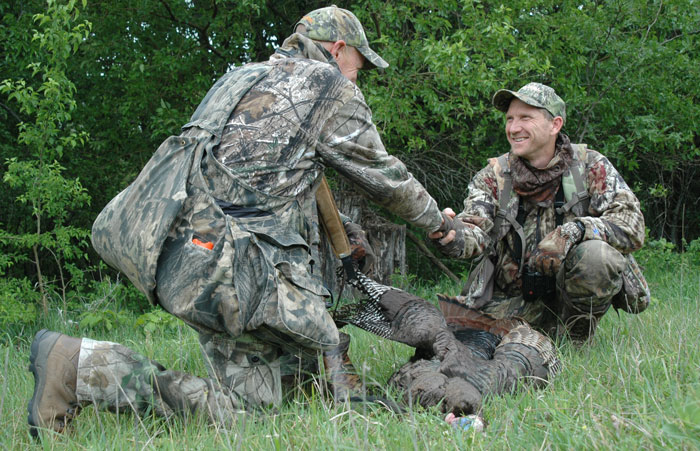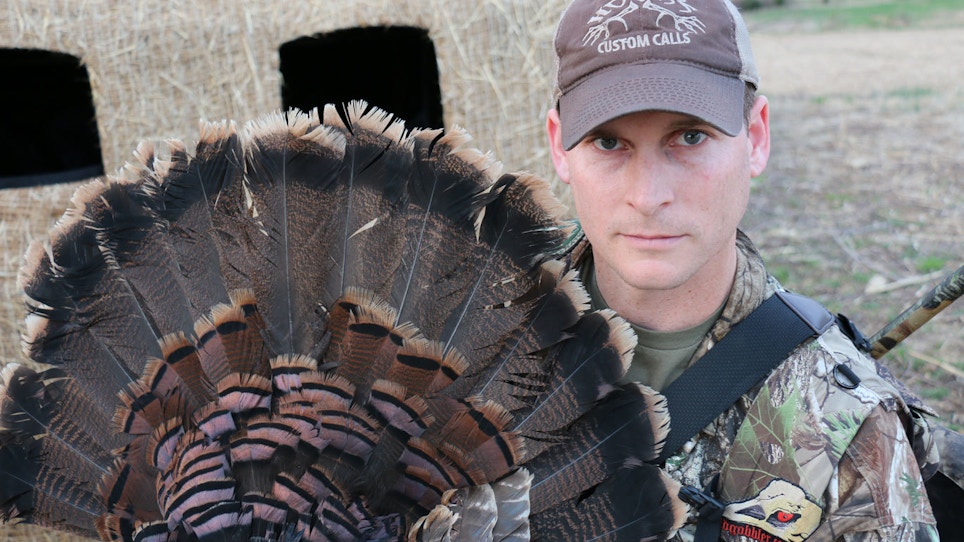Everyone admires guys who consistently kill turkeys despite the conditions. Those apex-level hunters are great callers and skilled woodsmen, but even they have go-to tactics for the toughest longbeards. We asked some of the top turkey hunters in the country to reveal theirs.
Scott Ellis, two-time Grand Nationals Head-to-Head champion said when all else fails, he loves to sneak in tight to a gobbler and then give him some soft yelping, clucking, purring and whining to seal the deal.
“Bear in mind that you have to be ultra-quiet and stealthy to ensure you don’t bump the bird,” he said. “I’ve found that when you get in tight with a gobbler and offer up the soft talk, more times than not, it will convince the gobbler he has been talking to an actual hen.”
Ernie Calandrelli, public relations director for Quaker Boy said he hunts a spring gobbler like he’s a cop and the gobbler is a dangerous criminal.
“Running in, setting up and making a few calls that brings certain gobblers in on the run does not always work,” he said. “Sometimes, gobblers that don’t cooperate like you would like them to take different tactics. Live with the bird, follow him, know where he spends most of his time and figure where and what time of the day he would be the most vulnerable to your calls.”
Shane Simpson, Minnesota State calling champion said he believes one of the best tactics for calling a turkey in is using a lot of aggressive calling.
“A lot of people say to take the bird’s temperature,” he said. “That’s almost impossible to do unless you can actually see the bird. Turkeys can gobble their heads off, or they can gobble periodically, and they both can be just as fired up. One might be doing a lot of strutting and the other might just be standing there gobbling, but they both might be just as excited as the other. Unless you can actually see them, it’s hard to figure that out. What I usually do is a lot of cutting and aggressive calling if they’re not coming my way right away, because I believe that has better odds of success. I’m not talking about just doing a few cutts and putting the call down. I mean running that call two or three minutes straight with nonstop cutting. Mix it up, throw some pauses in there and then get some rapid successions of cutts and cackles.”
Chris Parrish, two-time Grand Nationals Senior Division champion, three-time World calling champion said when it comes to killing gobblers consistently, he find roosting and a super-early morning setup to be the one thing that’s as close to foolproof as he has found.
“While this can be foiled when a bird moves or gets spooked off the roost by something, it has proven to be one of the most productive killing tactics I’ve use in my 37 years of hunting,” he said. “The reason I favor this tactic is [because] it constantly gives you a starting place. You seem to not be chasing your tail. If a hunter has time, anyone can use this tactic. I prefer to go in and really pinpoint the tree a gobbler is in by setting up a few hours before fly-up in places I have traditionally heard gobblers in the morning on a consistent basis. I like to call in the evening just a little to entice a looking gobbler to come close to my location to roost.”
 Tad Brown of Flambeau/M.A.D. Calls said a favorite tactic of his is to place the decoy behind him instead of in front.
Tad Brown of Flambeau/M.A.D. Calls said a favorite tactic of his is to place the decoy behind him instead of in front.
“Gobblers are famous for coming a long way, and then once they get close and see the decoy, they stop and wait for her to approach, as is the way nature intended it,” he said. “What happens is we typically set the decoy out front at good gun range, 20 to 30 yards, for the premium shot opportunity. Gobblers hold up about 40 to 50 yards from your deke and remain out of range. [When] it’s safe — and I prefer a nice big tree that’s as wide or wider than my back — I set the decoy about 20 yards behind me and off to the side about 10 yards, [so] I can still see it and take whichever shot opportunity is best. Usually, that’s the left side for right-handed shooters and the opposite for left-handed shooters.”
Steve Stoltz, World calling champion said one of his favorite tactics that would surprise you, since he’s a competition caller, is not calling.
“My no-call call can be almost as deadly as when I use my calls,” he said. “You have to read the bird’s mood and responsiveness and give the right amount of calling, accordingly. Many times, this means not calling at all for quite some time. I fell in love with this tactic when I discovered that sometimes not calling to them after getting them fired up with your calling can actually play on their ego. They will sometimes think the hen they were hearing has just walked off. Some will break and come see why in the world the hen would ever leave.”






